![]()
![]()
![]()
Use LEFT and RIGHT arrow keys to navigate between flashcards;
Use UP and DOWN arrow keys to flip the card;
H to show hint;
A reads text to speech;
6 Cards in this Set
- Front
- Back
- 3rd side (hint)

What are arrows pointing to?
General Information? Kingdom: Division: Order: Family: Genus: |
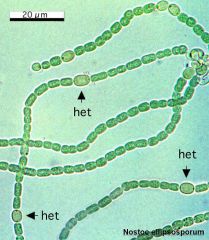
Kingdom: Bacteria
Division: Cyanobacteria Order: Nostocales Family: Nostocaceae Genus: Nostoc Nostoc is a genus of fresh water cyanobacteria that forms spherical colonies composed of filaments of moniliform cells in a gelatinous sheath. It can be found on moist rocks, at the bottom of lakes and springs, and rarely in marine habitats. |
|
|
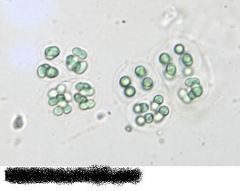
What is the name of this?
General Information? Kingdom? Division? Order? Genus? |

Kingdom: Bacteria
Division: Cyanobacteria Order: Chroococcales Genus: Gloeocapsa Gloeocapsa is a type of Photoautotrophic Bacteria (Cyanobacteria), and is a prokaryote. The cells secrete individual gelatinous sheaths which can often be seen as sheaths around recently divided cells within outer sheaths. Recently divided cell pairs often appear to be only one cell since the new cells cohere temporarily. |
Chocolate Chip Cookies
|
|
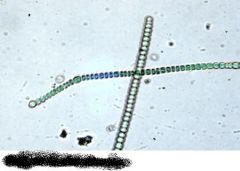
What is this organism?
General Information? Kingdom: Division: Order: Family: Genus: |

Kingdom: Bacteria
Division: Cyanophyta Class: Cyanophyceae Order: Nostocales Family: Nostocaceae Genus: Anabaena Anabaena is a genus of filamentous cyanobacteria, or blue-green algae, found as plankton. It is known for its nitrogen fixing abilities, and they form symbiotic relationships with certain plants. They are one of four genera of cyanobacteria that produce neurotoxins |
|
|
|
Kingdom: Eubacteria
Phylum: Cyanobacteria Order: Oscillatoriales Oscillatoria is a genus of filamentous cyanobacteria which is named for the oscillation in its movement. Filaments in the colonies can slide back and forth against each other until the whole mass is reorented to its light source. It is commonly found in watering-troughs waters, and is mainly blue-green or brown-green. Oscillatoria is an organism that reproduces by fragmentation. Oscillatoria forms long filaments of cells which can break into fragments called hormogonia. The hormogonia can grow into a new, longer filament. Breaks in the filament usually occur where dead cells are present. Oscillatoria uses photosynthesis to survive and reproduce. |
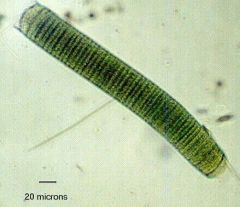
What is this organism?
General Information? Kingdom: Phylum: Order: |
|
|
|
Kingdom: Plantae
Division: Chlorophyta Class: Chlorophyceae Order: Volvocales Family: Chlamydomonadaceae Genus: Chlamydomonas Chlamydomonas is a genus of green alga. They are unicellular flagellates. The cell has a spherical cellulose membrane (theca), a stigma (eye-spot.)Asexual reproduction is by zoospores; sexual reproduction is by formation of gametes. Chlamydomonas is found in soil, ponds, and ditches polluted by manure. It may colour water green. |
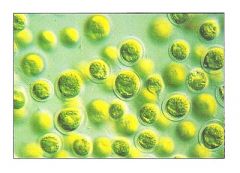
What is this Organism?
General Information? Kingdom: Division: Class: Order: Family: Genus: |
|
|
|
Kingdom: Protista
Division: Charophyta Phylum: Chlorophyta Order: Zygnematales Family: Zygnemataceae Genus: Spirogyra ound in freshwater and usually free-floating. The slippery unbranched filament is composed of cylindrical cells containing one or more beautiful spiral green chloroplasts, from which the genus gets its name. The nucleus is suspended in the central vacuole by fine cytoplasmic filaments. Vegetative reproduction is by fragmentation of the filament. The sexual phenomenon of conjugation also occurs; cells of two strands lying side by side are joined by the outgrowth of conjugation tubes. Rarely, cells of the same strand join end to end, and the contents of one cell passes into and fuses with the contents of the other. The resulting fused cell (zygote) is surrounded by a thick wall and overwinters while the vegetative filaments die. |
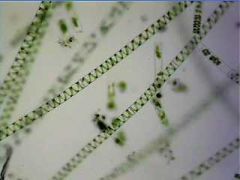
What is this organism
Kingdom: Division: Phylum: Order: Family: Genus: General Information? |
|

